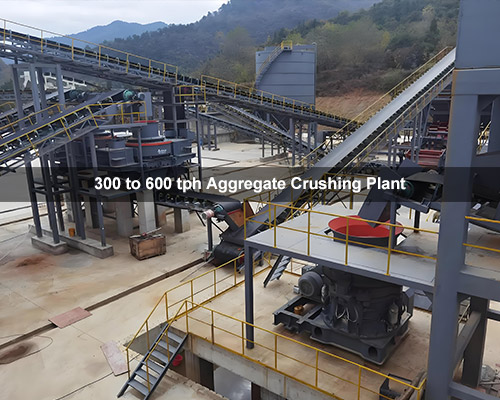In the mining and construction industries, setting up an efficient aggregate crushing plant is crucial for producing high-quality materials like sand, gravel, and crushed stone. For operations requiring a capacity of 300 to 600 tons per hour (tph), understanding the cost and components of an aggregate crushing plant is essential. This article delves into the key aspects of such plants, focusing on the role of aggregate crusher and how Liming Heavy Industry provides reliable solutions. We will cover material types, processing flows, equipment applications, capacity details, technological innovations, common challenges, case studies, and reasons to choose our products, all while addressing the core keywords: aggregate crusher, aggregate crushing plant, and 300 to 600 tph aggregate plant.

Material Introduction
Aggregate materials, such as granite, basalt, limestone, and river stone, are commonly processed in crushing plants. These materials are essential for construction projects, including roads, buildings, and infrastructure. In a 300 to 600 tph aggregate plant, the primary goal is to crush large rocks into smaller, uniform sizes for various applications. The choice of material impacts the selection of crusher and overall plant design, ensuring optimal performance and cost-efficiency.
Material Crushing Process Flow
The process in an aggregate crushing plant typically involves several stages: primary crushing, secondary crushing, and screening. First, raw materials are fed into a primary crusher, such as a jaw crusher, to reduce large rocks into smaller pieces. Then, secondary crusher, like impact or cone crusher, further refine the material. Finally, screening equipment separates the crushed aggregate into different sizes. This streamlined flow ensures high productivity and meets the demands of a 300 to 600 tph aggregate plant, minimizing downtime and maximizing output.
Application Range of Our Crushing Equipment
At Liming Heavy Industry, our aggregate crusher are designed for a wide range of applications, including quarrying, mining, and recycling. For instance, our PE series jaw crusher and PF series impact crusher are ideal for handling hard and abrasive materials in a 300 to 600 tph aggregate crushing plant. These machines are versatile and can be integrated into various configurations to suit specific project needs, from stationary plants to mobile setups, ensuring flexibility and efficiency in aggregate production.
Capacity and Types of Crusher
When it comes to capacity, a 300 to 600 tph aggregate plant requires robust equipment to handle high volumes. Liming Heavy Industry offers a range of crusher with varying capacities and types. For example, our PE-900×1200 jaw crusher can achieve up to 300 tph, while the HPT300 cone crusher and PF-1315 impact crusher are suitable for secondary crushing in this range. These aggregate crusher are engineered for durability and high performance, ensuring consistent output in demanding environments. The choice of crusher type—whether jaw, cone, or impact—depends on the material hardness and desired product size, allowing for customized solutions in any aggregate crushing plant.
Technology and Innovation in Crushing Equipment
Innovation is at the core of Liming Heavy Industry’s products. Our aggregate crusher incorporate advanced technologies such as hydraulic adjustment systems, intelligent control panels, and energy-efficient motors. For instance, the HPT series cone crusher feature a unique crushing chamber design that enhances efficiency and reduces wear. These innovations help lower operational costs and improve the reliability of a 300 to 600 tph aggregate plant, making our equipment a smart choice for modern mining operations.
Common Challenges and Solutions
Operating a 300 to 600 tph aggregate crushing plant can present challenges like high wear and tear, uneven material flow, and maintenance issues. To address these, Liming Heavy Industry provides solutions such as wear-resistant parts in our PF series impact crusher and automated lubrication systems in HPT cone crusher. Regular maintenance schedules and real-time monitoring also help prevent downtime, ensuring that the aggregate crushing plant runs smoothly and cost-effectively.
Case Study: Successful Implementation of a 500 tph Aggregate Plant
In a recent project, a customer in Asia implemented a 500 tph aggregate crushing plant using Liming Heavy Industry equipment. The setup included a PE-1200×1500 jaw crusher for primary crushing and two HPT400 cone crusher for secondary processing. Over six months, the plant achieved an average output of 480-520 tph, with a reduction in operational costs by 15% due to our energy-efficient designs. This case study demonstrates how our aggregate crusher can deliver reliable performance in a high-capacity aggregate plant, backed by data and real-world results.
Why Choose Liming Heavy Industry?
Choosing Liming Heavy Industry for your aggregate crushing plant means investing in quality, innovation, and support. Our products, such as the PE, PF, and HPT series, are built to last and come with comprehensive after-sales services. We focus on customer-centric solutions, offering customized designs for 300 to 600 tph plants that optimize cost and efficiency. With decades of experience in manufacturing crushing equipment, we ensure that every aggregate crusher meets international standards, providing peace of mind for your investment.
Conclusion
Setting up a 300 to 600 tph aggregate crushing plant involves careful planning and the right equipment selection. By leveraging Liming Heavy Industry’s advanced aggregate crusher and crushing plants, businesses can achieve high productivity, cost savings, and long-term reliability. Whether you’re dealing with hard rocks or need a customized solution, our expertise and innovative technologies make us a trusted partner in the aggregate industry. For more details on our products, visit our website or contact our team to discuss your specific needs.

